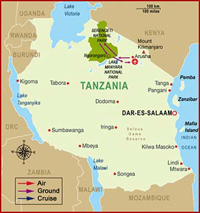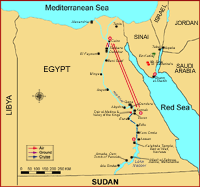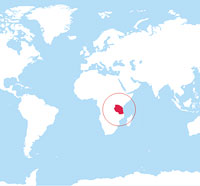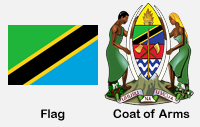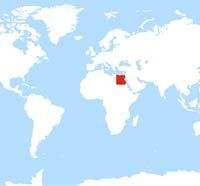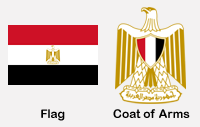You are here: Home / Destinations / Egypt & Tanzania Safari
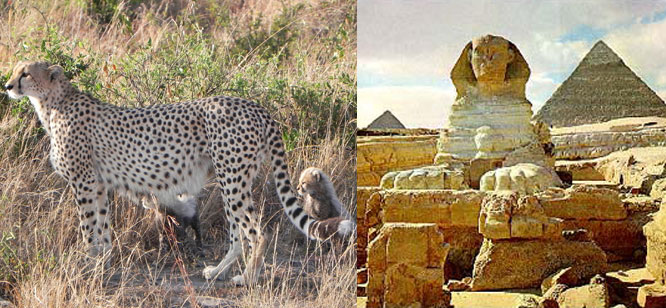
Egypt & Tanzania Safari
PRIVATE TOUR
EGYPT: Fully escorted throughout by licensed Egyptologists, includes the "A" list of Pharaonic sites in Cairo and Luxor plus breakfast daily. Entry fees included for all sites shown in the tour program.
Our private tours assure you the personal attention for which our firm is famous. Operates weekly however space is limited. Early booking encouraged.
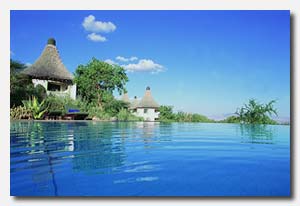
SAMPLE TOUR:
Day 01: (Sunday) ARRIVE CAIRO, TRANSFER TO STEIGENBERGER PYRAMIDS HOTEL
Arriving Cairo staff assists with clearing immigration and customs then transfers you to the Steigenberger Pyramids hotel where you will have a Pyramid View room. Overnight Cairo
VISA: All travelers to Egypt are required to obtain a visa. Travelers from many countries can get theirs on arrival or on the web at:
https://www.visa2egypt.gov.eg
Day 02: (Monday) SAQQARA, DAHSHUR, GIZA
Meet your guide in the hotel lobby at 8:30AM for a tour of:
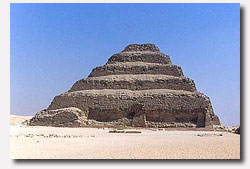 Saqqara featuring the Step Pyramid. It is the oldest complete stone building complex known in history. Djoser's step pyramid was built during the Third Dynasty (about 2600 BC). Another 16 Egyptian kings built pyramids at Saqqara, which are now in various states of preservation or dilapidation. High officials added private funeral monuments to this necropolis during the entire pharaonic period. It remained an important complex for non-royal burials and cult ceremonies for more than 3,000 years, well into Ptolemaic and Roman times. Visit the elaborate tombs of Mereruka (vizier to king Teti), the tomb of Maia (King Tut's wet nurse and maybe half sister) and the 4,200 year old tomb of Mehu.
Saqqara featuring the Step Pyramid. It is the oldest complete stone building complex known in history. Djoser's step pyramid was built during the Third Dynasty (about 2600 BC). Another 16 Egyptian kings built pyramids at Saqqara, which are now in various states of preservation or dilapidation. High officials added private funeral monuments to this necropolis during the entire pharaonic period. It remained an important complex for non-royal burials and cult ceremonies for more than 3,000 years, well into Ptolemaic and Roman times. Visit the elaborate tombs of Mereruka (vizier to king Teti), the tomb of Maia (King Tut's wet nurse and maybe half sister) and the 4,200 year old tomb of Mehu.
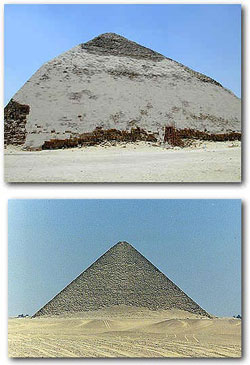 The Bent Pyramid was the first attempt at a smooth-sided pyramid but ultimately wasn't successful. One design flaw was that there was a very unstable base for it made of desert gravel and clay that has the tendency to subside when a large amount of weight is put on top of it. Another design flaw in this pyramid is that the engineering of it consisted of the blocks being cut in such a way that the weight angles down, causing all of the weight of the pyramid to push down towards the center. This in turn is thought to be the reason the pyramid is "bent" and changes angles about halfway up the sides.
The Bent Pyramid was the first attempt at a smooth-sided pyramid but ultimately wasn't successful. One design flaw was that there was a very unstable base for it made of desert gravel and clay that has the tendency to subside when a large amount of weight is put on top of it. Another design flaw in this pyramid is that the engineering of it consisted of the blocks being cut in such a way that the weight angles down, causing all of the weight of the pyramid to push down towards the center. This in turn is thought to be the reason the pyramid is "bent" and changes angles about halfway up the sides.
Sneferu was not pleased with this pyramid, so he built another called the Red Pyramid. Getting its name from the red hue the pyramid gives off after a nice rain, the Red pyramid was the first true smooth-sided pyramid. Standing more than 30 stories tall, it is thought to be Sneferu's pride and glory and the place where he is believed to be buried. The Red pyramid was the largest smooth-sided pyramid standing until Sneferu's son, Khufu, outdid his father by building the Great Pyramid of Giza, which stands 490 feet tall. Though Khufu's pyramid is larger, he would not have been able to build it without the knowledge that his father discovered before him. The Bent Pyramid is open for entry.
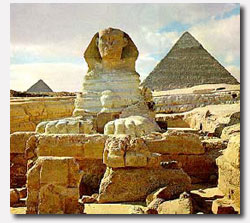 Continue your tour with a visit to the Giza Plateau with the famous Great Pyramid and Sphinx. Dominating the plateau and running in a southwest diagonal through the site are the three pyramids of the pharaohs Khufu, Khafra, and Menkaura. The northernmost, and the largest, one belongs to Khufu. Khafra's pyramid is built precisely on a southwest diagonal to his father's pyramid, as well as having been built on higher ground to create the illusion of being bigger. The pyramid of Menkaura is much smaller and is not aligned along the same diagonal line as the other two pyramids.
Continue your tour with a visit to the Giza Plateau with the famous Great Pyramid and Sphinx. Dominating the plateau and running in a southwest diagonal through the site are the three pyramids of the pharaohs Khufu, Khafra, and Menkaura. The northernmost, and the largest, one belongs to Khufu. Khafra's pyramid is built precisely on a southwest diagonal to his father's pyramid, as well as having been built on higher ground to create the illusion of being bigger. The pyramid of Menkaura is much smaller and is not aligned along the same diagonal line as the other two pyramids.
The Sphinx is the largest monolith statue in the world and it is the oldest known monumental sculpture. Commonly held to have been built by ancient Egyptians of the Old Kingdom during the reign of the Pharaoh Khafra there are some who believe it is much, much older. Overnight Cairo
Meals: Breakfast
Day 03: (Tuesday) GRAND EGYPTIAN MUSEUM
The 5.2-million-square-foot Grand Egyptian Museum is the world's largest museum devoted to a single civilization. (As a reference the Smithsonian in Washington is 1.5 million square feet). For the first time every artifact found in King Tut's tomb will be displayed. Overnight Cairo
Meals: Breakfast
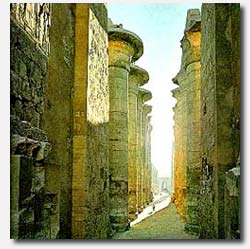 Day 04: (Wednesday) FLY TO LUXOR, TEMPLES OF KARNAK & LUXOR, ACHTI RESORT
Day 04: (Wednesday) FLY TO LUXOR, TEMPLES OF KARNAK & LUXOR, ACHTI RESORT
Staff transfers you to the airport, assists with checking in and you fly to Luxor. Arriving enjoy a guided tour of the Temples of Karnak and Luxor before checking in at the Steigenberger Achti resort where you will have a Nile view room with excellent views of the Necropolis. Overnight Luxor
Meals: Breakfast
Day 05: (Thursday) EXTENDED NECROPOLIS, FELUCCA
Start the tour with a visit to the Valley of the Kings: A truly impressive site! There, you will find Tutankhamen’s tomb which was discovered almost intact in 1922 and the tomb of Ramses IV, among others. A ticket will allow you visiting 3 of the 63 tombs on site, except Tutankhamen’s tomb and Seti I tomb, both of which requires an additional ticket (cost not included).
Continue to the Valley of the Queens: Located on the West Bank of Luxor near the Valley of the Kings, the Valley of the Queens is the place where wives of Pharaohs were buried in ancient times as well as princes, princesses and various members of the nobility. Optional (extra cost) entry to Queen Nefertari's tomb arranged on site.
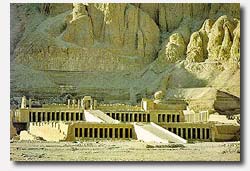 Tour Hatshepsut's temple: Hatshepsut’s temple is considered the closest Egypt came to Classical architecture. Representative of New Kingdom funerary architecture, it both aggrandizes the pharaoh and includes sanctuaries to honor the gods relevant to her afterlife. This marks a turning point in the architecture of Ancient Egypt, which forsook the megalithic geometry of the Old Kingdom for a temple which allowed for active worship, requiring the presence of participants to create the majesty. The linear axiality of Hatshepsut’s temple is mirrored in the later New Kingdom temples. The architecture of the original temple has been considerably altered as a result of misguided reconstruction in the early twentieth century AD.
Tour Hatshepsut's temple: Hatshepsut’s temple is considered the closest Egypt came to Classical architecture. Representative of New Kingdom funerary architecture, it both aggrandizes the pharaoh and includes sanctuaries to honor the gods relevant to her afterlife. This marks a turning point in the architecture of Ancient Egypt, which forsook the megalithic geometry of the Old Kingdom for a temple which allowed for active worship, requiring the presence of participants to create the majesty. The linear axiality of Hatshepsut’s temple is mirrored in the later New Kingdom temples. The architecture of the original temple has been considerably altered as a result of misguided reconstruction in the early twentieth century AD.
Tour the tombs of the Nobles and artisans. The Tombs of the Nobles are a study in contrasts to their royal counterparts. Whereas royalty favored concealed tombs in secluded valleys, Theban nobles and high officials were ostentatiously interred in the limestone foothills overlooking the great funerary temples of their masters. The pharaohs’ tombs were sealed and guarded; the nobles’ were left open for their descendants to make funerary offerings. Whereas royal tombs are filled with scenes of judgement and resurrection, the nobles’ chosen artwork dwells on earthly life and its continuation in the hereafter. Given more freedom of expression, the artists excelled themselves with vivid paintings on stucco (the inferior limestone on this side of the hills militates against carved reliefs). Additional sites include:
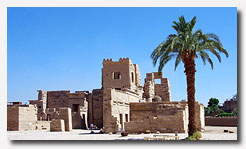
MEDINET HABU: The Mortuary Temple of Ramses III has well preserved Ancient Egyptian art and architecture. Walk through the remnants of the workers’ mud brick houses at the rear of the site, and then into the grandness of the temples. Hatshepsut and Tuthmosis III oversaw the building of the original temple of Amun which was later walled in to the complex by Ramses III. The entrance to this temple complex is through the singular Syrian Gate, this large building is unique to Madinet Habu and is carved with giant images of the Ramses III defeating the Libyans.
RAMESSEUM: The Ramesseum is the memorial temple of the great warrior king Ramesses II. One of the largest and best-preserved of these temples, this "Mansion of Millions of Years" contains the fallen colossus that inspired Percy Bysshe Shelleys poem, Ozymandias. Scenes from the king's great Battle of Qadesh (in which only Ramesses II's personal valor saved the Egyptians from ignominious defeat at the hands of the Hittites) adorn the first and second pylons. The king's successful campaign against the Syrian fortress of Dapur is illustrated in the hypostyle hall, along with images of the king receiving his regalia from the god Amun-Re. The plan of the temple is typical for the New Kingdom. Behind the pylons are courts, and then a pillared hall filled with columns in the form of marsh plants, an finally a bark shrine for the sacred boat of the god and the inner sanctuary. The floor rises and the ceiling drops as one enters the temple further, to evoke the moment in which the Egyptian universe was created from the primeval mound that rose from the endless waters of the flood. The complex also includes a palace for the king and extensive storerooms and granaries built of mud brick. A large quantity of ostraca found at the site has led scholars to suggest that a scribal school or library was located here, as mentioned by the Greek historian Diodorus Siculus.
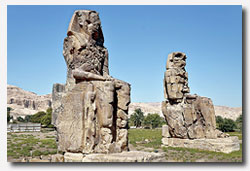 COLOSSI OF MEMNON: Two massive stone statues of Pharaoh Amenhotep III, who reigned during Dynasty XVIII. For the past 3,400 years (since 1350 BC) they have stood in the Theban necropolis, west of the River Nile from the modern city of Luxor. The twin statues depict Amenhotep III in a seated position, his hands resting on his knees and his gaze facing eastwards towards the river. Two shorter figures are carved into the front throne alongside his legs: these are his wife Tiy and mother Mutemwiya. The side panels depict the Nile god Hapy. The statues are made from blocks of quartzite sandstone. The original function of the Colossi was to stand guard at the entrance to Amenhotep's memorial temple (or mortuary temple): a massive construct built during the pharaoh's lifetime, where he was worshipped as a god-on-earth both before and after his departure from this world. In its day, this temple complex was the largest and most opulent in Egypt. Covering a total of 86 acres, even later rivals such as Ramesses II's Ramesseum or Ramesses III's Medinet Habu were unable to match it in area; even the Temple of Karnak, as it stood in Amenhotep's time, was smaller.
COLOSSI OF MEMNON: Two massive stone statues of Pharaoh Amenhotep III, who reigned during Dynasty XVIII. For the past 3,400 years (since 1350 BC) they have stood in the Theban necropolis, west of the River Nile from the modern city of Luxor. The twin statues depict Amenhotep III in a seated position, his hands resting on his knees and his gaze facing eastwards towards the river. Two shorter figures are carved into the front throne alongside his legs: these are his wife Tiy and mother Mutemwiya. The side panels depict the Nile god Hapy. The statues are made from blocks of quartzite sandstone. The original function of the Colossi was to stand guard at the entrance to Amenhotep's memorial temple (or mortuary temple): a massive construct built during the pharaoh's lifetime, where he was worshipped as a god-on-earth both before and after his departure from this world. In its day, this temple complex was the largest and most opulent in Egypt. Covering a total of 86 acres, even later rivals such as Ramesses II's Ramesseum or Ramesses III's Medinet Habu were unable to match it in area; even the Temple of Karnak, as it stood in Amenhotep's time, was smaller.
FREE BONUS: End the day with a sail on the Nile by Felucca (native sailboat). NOTE: these boats are solely wind powered. If there is not sufficient wind this will not operate. Overnight Luxor
Meals: Breakfast
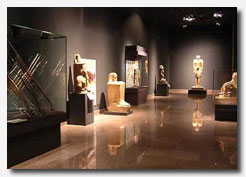 Day 06: (Friday) LUXOR MUSEUM, FLY TO CAIRO, DEPART TO TANZANIA
Day 06: (Friday) LUXOR MUSEUM, FLY TO CAIRO, DEPART TO TANZANIA
Rick Steves commented: "The Luxor Museum, made possible and designed by the people who brought us the Louvre in Paris, is the finest museum in the country".
Most of the artifacts displayed at the Luxor Museum were discovered in the area of ancient Thebes (modern Luxor). Highlights of the collection include masterpieces of pharaonic art as well as examples of everyday objects. Several galleries are devoted to a spectacular group of statues found in 1989 hidden beneath the floor of the Luxor Temple; there is also an annex dedicated to Egypt's Golden Age (the New Kingdom, ca. 1550-1070 BC), which includes two royal mummies and a short film on ancient papyrus and vase-making. After the tour staff transfers you to the airport for your flight to Cairo. Arriving staff transfers you to the international terminal, assists with exit formalities and checking in for your departure to Tanzania on Egyptair at 21:45 which flies nonstop to Nairobi. Arriving 03:30 (Sunday) transfer to Precision Air departing Nairobi at 08:20 to Arusha. Arriving 09:20. (meals on the flight)
PRIVATE EGYPT TOUR INCLUDES: Transfers by air-conditioned vehicle related to the tour starting with arrival in Cairo. Baggage handing of no more than 1 piece of luggage per person, however, baggage and personal effects are at the owner's risk at all times during the tour. Domestic Egypt flights (Cairo - Luxor round trip) in economy class. Hotels (based on double occupancy). Meals as outlined by B for breakfast, L for lunch, and D for dinner in the hotel's main dining room. Fees for visiting antiquity sites and museums that are part of the tour program except optional sites. Tours with the services of an English speaking Egyptologist. Service charges and taxes.
Not included: items of a personal nature such as International air, entry visa, tips, telephone, laundry, beverages of any nature at any time, meals in speciality restaurants or room service, anything not specifically mentioned as included.
 TANZANIA
TANZANIA
All visitors to Tanzania are required to have a Visa. Please check https://eservices.immigration.go.tz/visa/ for the latest information.
Day 07: (Saturday) ARUSHA, LAKE MANYARA
Arriving 09:20 clear immigration and customs then meet your driver in the terminal lobby. Lunch in Arusha (on your own) then in the afternoon drive to Lake Manyara. Dinner and overnight at the Serena lodge.
Meals: Dinner
Day 08: (Sunday) LAKE MANYARA, SERENGETI
Enjoy a morning game drive in Lake Manyara National Park whose inhabitants include hippos, monkeys, tree climbing lions, flamingos and other varieties of birdlife. Lunch at the lodge. Then, drive to Serengeti National Park. Dinner and overnight at the Serena lodge.
Meals: Breakfast, Lunch, Dinner
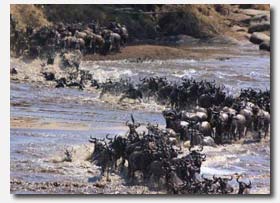
Day 09: (Monday) SERENGETI
Enjoy morning and afternoon game drives in the endless plains of the Serengeti for a chance to see the great herds of wildebeest, zebras and gazelles or a pride of lions lounging in the shade. Meals and overnight at the Serena lodge in Serengeti.
Meals: Breakfast, Lunch, Dinner
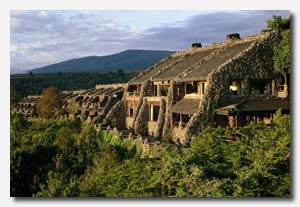
Day 10: (Tuesday) SERENGETI, OLDUVAI GORGE, NGORONGORO
Depart for a morning game drive in the Serengeti National Park. Lunch at the lodge. After lunch drive to Olduvai Gorge, site of Louis and Mary Leakey’s renowned archaeological discoveries. Their findings include some of the man’s earliest known ancestral remains. Continue driving to Ngorongoro Conservation Area for dinner and overnight and the Serena lodge.
Meals: Breakfast, Lunch, Dinner
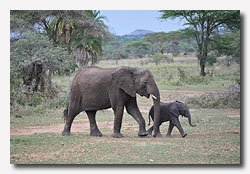
Day 11: (Wednesday) NGORONGORO
Today you will descend 2000 feet (0ver 600 metres) to the floor of the crater for a day crater tour with picnic lunches. Explore the forest areas that are inhabited by monkeys and elephants, the lake area, where you may see the flamingos and the open savannah where the lions hunt for food. Dinner and overnight at the Serena lodge in Ngorongoro.
Meals: Breakfast, Lunch, Dinner
Day 12: (Thursday) INTERNATIONAL DEPARTURE
After breakfast, drive back to Arusha for your international departure.
Meals: Breakfast
TANZANIA PRIVATE TOUR INCLUDES:
 Transfers from arrival to Arusha pertaining to the tour, hotels (based on double occupancy) meals in the main dining room or on game viewing safari as noted. Picnic lunches (featuring hot and cold dishes) prepared on site while on safari. Entry fees to sites described in the program, service charges and taxes.
Transfers from arrival to Arusha pertaining to the tour, hotels (based on double occupancy) meals in the main dining room or on game viewing safari as noted. Picnic lunches (featuring hot and cold dishes) prepared on site while on safari. Entry fees to sites described in the program, service charges and taxes.
NOT included are: Air, items of a personal nature such as tips, telephone, laundry, beverages of any nature at any time, room service of any type and anything not specifically mentioned as included.
Tour Cost:
Please send dates of travel and number of travelers for a firm quote.
-
Tours must be booked at least 45 days prior to arrival.
Prices and itinerary subject to change without notice.
Single Price is for Single occupancy hotel rooms and cruise cabins based on a minimum of two travelers. Single travelers (one person on the tour) would have additional cost.
Inquire about this tour
Terms & Conditions


